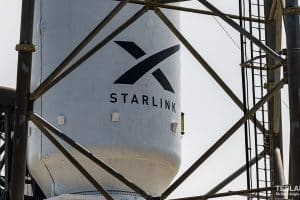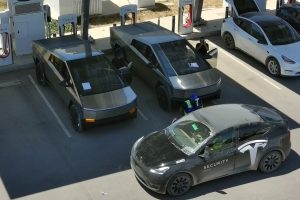- 🔌 Tesla’s North American Charging Standard (NACS) has been widely adopted by automakers in the United States.
- 🎥 Tesla was spotted filming a promotional video featuring its Supercharger Network, including non-Tesla electric cars like the Ford Mustang Mach-E and GMC Hummer EV.
- 📹 Electric vehicle enthusiasts anticipate an upcoming video advertisement highlighting NACS adoption, given the presence of multiple non-Tesla EVs at the Supercharger site.
- 🚗 Stellantis, the last large automaker to hold out on NACS adoption, recently announced its decision to embrace the standard for its EVs.
- 📊 Other major automakers such as Ford, General Motors, Toyota, Honda, Volkswagen, BMW, and Hyundai have also committed to adopting Tesla’s NACS.
- 🔌 Public charging networks like ChargePoint and Electrify America are also beginning to support the NACS standard, adding NACS connectors to their charging stalls.
- 📅 Tesla introduced the North American Charging Standard (NACS) in November 2022, emphasizing the superiority of its charging connector over the Combined Charging System (CCS) connectors.
The electric vehicle (EV) industry is witnessing a significant transformation, with advancements not only in vehicle technology but also in charging infrastructure. One of the pivotal developments in this realm is the widespread adoption of Tesla’s North American Charging Standard (NACS). Let’s delve into this revolutionary standard and its implications for the future of EV charging.
Understanding Tesla’s North American Charging Standard (NACS)
Tesla’s NACS is a charging standard designed to streamline EV charging across different manufacturers. Introduced in November 2022, it offers several advantages over existing standards, particularly the Combined Charging System (CCS) connectors. Tesla’s charging connector boasts superior performance, with capabilities for both AC and DC charging, including up to 1 MW DC charging, all within a compact and efficient design.
Adoption by Automakers
The rapid adoption of Tesla’s NACS by major automakers marks a significant shift in the industry landscape. Companies like Ford, General Motors, Toyota, Honda, Volkswagen, BMW, Hyundai, and more have committed to embracing the NACS standard for their EVs. This collective endorsement underscores the industry’s recognition of Tesla’s leadership in charging infrastructure.
Stellantis Joins the Fold
Stellantis, the parent company of renowned automotive brands such as Jeep, Ram, Chrysler, Dodge, and others, recently announced its decision to adopt Tesla’s NACS for its electric vehicles. This move is particularly noteworthy as Stellantis was the last major automaker to hold out on NACS adoption. With Stellantis onboard, the NACS standard achieves even greater prominence and acceptance within the industry.
Promotional Initiatives and Filming
The recent sighting of Tesla filming a promotional video featuring its Supercharger Network and non-Tesla electric cars at a Supercharger site has sparked excitement among EV enthusiasts. The inclusion of vehicles like the Ford Mustang Mach-E and GMC Hummer EV in the video signals a concerted effort to showcase the interoperability and convenience of charging under the NACS standard.
Expansion Beyond Automakers
Beyond automakers, public charging networks are also embracing the NACS standard. Companies like ChargePoint and Electrify America are integrating NACS connectors into their charging infrastructure, alongside their existing CCS connectors. This expansion of NACS support extends the benefits of Tesla’s charging standard to a wider network of EV drivers, fostering greater accessibility and convenience.
Looking Ahead
As the adoption of Tesla’s NACS continues to gain momentum, the future of EV charging appears increasingly promising. The standardization of charging protocols not only simplifies the charging experience for consumers but also promotes interoperability and collaboration within the industry. With Tesla’s NACS serving as a unifying force, the EV ecosystem is poised for further growth and innovation in the years to come.





